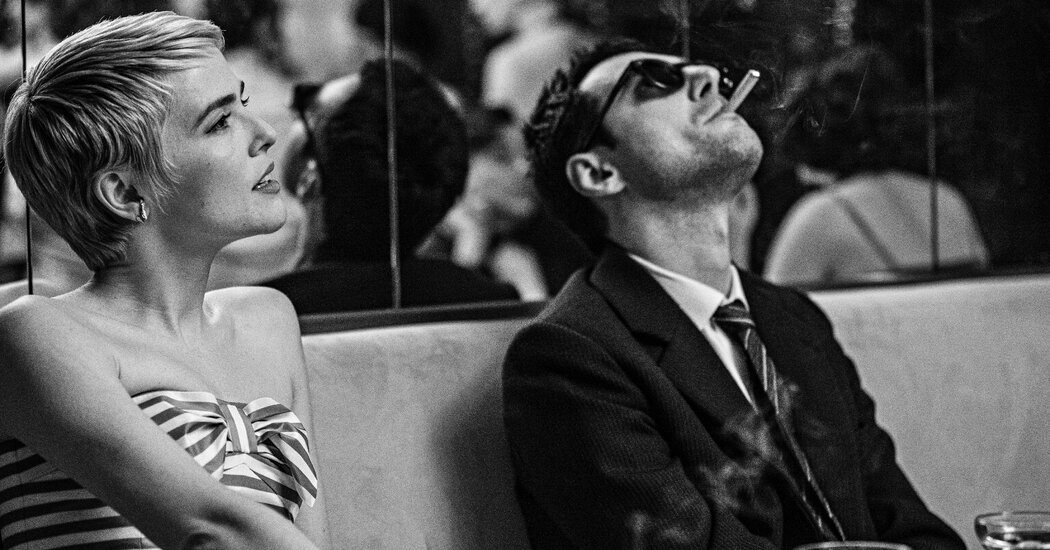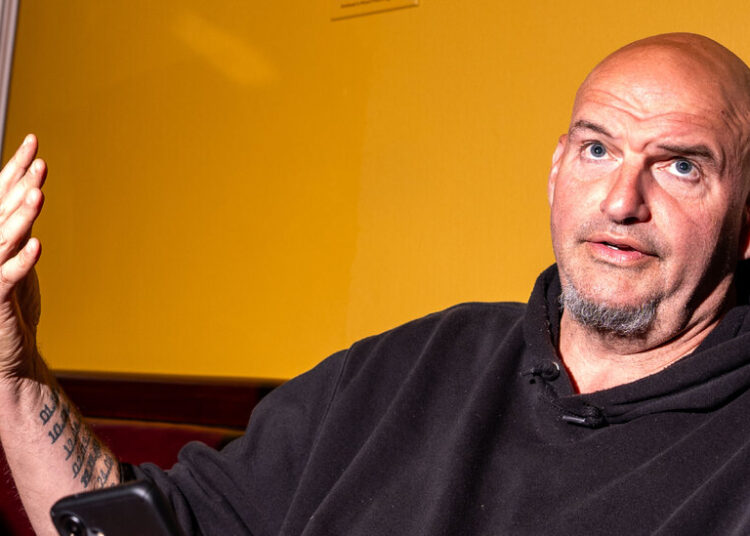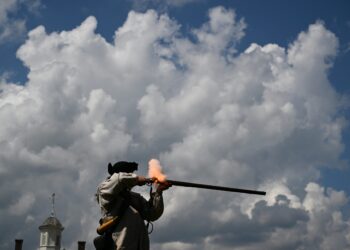
Richard Linklater’s “Nouvelle Vague,” a film about filmmaking, is suffused with intoxicating glamour — the glamour of youth, of beauty, of grand aesthetic pursuits, Paris at twilight and, bien sûr, cinema itself. Set largely in Paris in 1959 and almost entirely in French, it revisits the title movement that was embodied by young moviemakers who upended and disregarded cinematic norms with the kinds of stories they were telling and, crucially, how. With new attitudes, techniques, technologies, casts, crews and with one another’s support, they were borrowing from the past, engaging with the present and creating the future.
“A whole galaxy of young people,” the filmmaker Pierre Kast said that year to Jean-Luc Godard, “are in the process of taking the old Bastille of the French cinema by assault.”
That assault is already well on its way by the time that Linklater opens his film, which re-creates how the 29-year-old Godard came to direct “Breathless,” his first feature. Played with seductive and fitting opacity by the newcomer Guillaume Marbeck, the Jean-Luc here isn’t typical of the protagonist familiar from screen biographies. There’s little about his past, his family, schooling, favorite wine or tobacco flavor, or how he came to write film criticism for Cahiers du Cinéma alongside other Young Turks like François Truffaut (Adrien Rouyard), Claude Chabrol (Antoine Besson) and Éric Rohmer (Côme Thieulin).
The birth that Linklater revisits isn’t that of an individual but rather of a film and an artist who became a movement’s apotheosis. “Nouvelle Vague” is about art, love, freedom and friendship, among other things, but it’s also about a moment in time, like Linklater’s recent “Blue Moon,” a melancholic portrait of the lyricist Lorenz Hart set on the night of the premiere of “Oklahoma!” Created by Hart’s longtime partner, the composer, Richard Rodgers, and the lyricist Oscar Hammerstein II, the musical was widely acclaimed; to some, though, it signaled the triumph of the middlebrow, which presents itself as high culture in attenuated, audience-pandering form. In similar fashion, the Cahier group savaged what it saw as French cinema’s “tradition of quality,” its sterile conventions and commercial imperatives.
The time frame in “Nouvelle Vague” is more expansive than that in “Blue Moon”; opening in 1958, the new film continues through much of 1959, but it too revisits a specific cultural flashpoint. Linklater sketches in the period with focus and fluid storytelling, using the making of “Breathless” to illustrate a larger context. In short order, he introduces Godard — quick-witted, sharp-tongued, vibrating with anxious energy behind his ever-present sunglasses — as well as his circle, including his cohort at Cahiers and some others; Agnès Varda takes a bow, as does Jacques Demy. By that point, Jean-Luc has made short films, yet his pals at Cahiers have already shot their first features. Chabrol will soon direct his third.
To tell this story, Linklater handsomely mimes the familiar look of some of that era’s movies, shooting “Nouvelle Vague” in luscious black-and-white film using the traditional Academy (square) framing. He does a great deal in that box, which he fills with graceful compositions as well as lively, interesting faces and gestures that express what the script wisely doesn’t spell out. (The credited writers are Holly Gent, Vincent Palmo Jr., Michèle Halberstadt and Laetitia Masson.) He also charts the larger history, if often relaying it elliptically, as during an openly emotional visit to the Cahiers office by Roberto Rossellini, a foundational influence on the French New Wave who amusingly hits Godard up for money. Here as elsewhere, Linklater shrewdly uses humor to keep things from getting overly precious.
Such scenes are cinephile catnip, and it’s a kick to see how Linklater re-creates this moment, which opens with Jean-Luc and three friends sitting in a cinema wreathed in cigarette smoke impassively watching a film that’s mostly of interest to them for its after party. It’s there that Jean-Luc, amid chatting up an attractive actress and despairing about his prospects, insults the producer of the film that he’s just seen. Sometime later — right after the triumphant screening at Cannes of Truffaut’s inaugural feature, “The 400 Blows” — that same producer agrees to back Jean-Luc’s first feature. Jean-Luc has other films he wants to make, but the producer insists on “Breathless” explicitly because it was written by the newly hot Truffaut.
Once the budget is secure, the film is a go — it’s based on a real story about a French criminal and an American journalist — and Linklater’s movie and Jean-Luc simultaneously take off, equally energized. Jean-Luc visits a boxing gym to speak to Jean-Paul Belmondo (Aubry Dullin), who will play the Bogart-influenced hood, and crashes a party attended by the young American star, Jean Seberg (Zoey Deutch), who will take on the role of the film’s femme fatale. Jean-Luc also ropes in Raoul Coutard (Matthieu Penchinat), a former war photographer turned cinematographer who went on to shoot some of the New Wave’s most iconic movies. Working fast, shooting without sound (it was added later), using both real locations and natural light, Jean-Luc and his tiny, equally young cast and crew make history.
The scenes of the making of “Breathless” are charming and often funny, with a lightness of touch that’s in keeping with the original film, its rushed production (it was shot in four weeks) and enduring freshness. Linklater conveys the shoot’s hurdles and workarounds — “Find cheap technical solutions to logistical problems,” Rossellini advises — as well as its alliances and tensions. Jean-Luc and Coutard rapidly fall into productive synchronicity while Belmondo and Seberg develop a playful flirtation. More than most, she expresses her frustration with Jean-Luc’s gnomic utterances, his quotations and a method (anti-method) that’s at odds with her experiences in Hollywood. And no wonder: “What I wanted was to take a conventional story and remake, but differently, everything the cinema had done,” Godard said later.
In challenging established (intransigent!) ideas about movies in general and American cinema in particular in their criticism, members of the French New Wave were instigating a debate about cinema and laying the groundwork for their own insistently modern films. Importantly, they fiercely championed the visual over the literary in cinema and recognized the persistence of the personal even in Hollywood. For them, even directors (the blessed ones, at any rate) operating within the confines of the studio system could be artists like any other. Cahiers called this the “politique des auteurs,” which the American critic Andrew Sarris popularized as the auteur theory. Whatever its merits and limitations, this notion helped inspire other cine-waves, including in New Hollywood and in American independent cinema.
There is a conspicuous autobiographical component to “Nouvelle Vague” for Linklater, who shot his first feature, “Slacker,” in 1989 on a shoestring budget. In the years since, as big Hollywood continued to shrink to its current diminished state, the American independent cinema movement blew up into something called Indiewood only to retreat into cycles of crisis and retrenchment. For his part, Linklater kept making movies, including about artists and art. When I saw “Nouvelle Vague” at Cannes earlier this year, I initially classified it as a delightful, explicitly non-Godardian homage. Watching it again, I recognized that Linklater’s film is itself an expression of a certain approach — a consciousness — toward cinema’s pleasures and possibilities, one that at once embraces the art’s past and insists on its future.
Nouvelle Vague
Rated R, for some prop guns (a ridiculous rating no matter how you look at it). In French, Italian and English, with subtitles. Running time: 1 hour 46 minutes. Watch on Netflix.
Manohla Dargis is the chief film critic for The Times.
The post ‘Nouvelle Vague’ Review: Richard Linklater Ode to ‘Breathless’ appeared first on New York Times.



